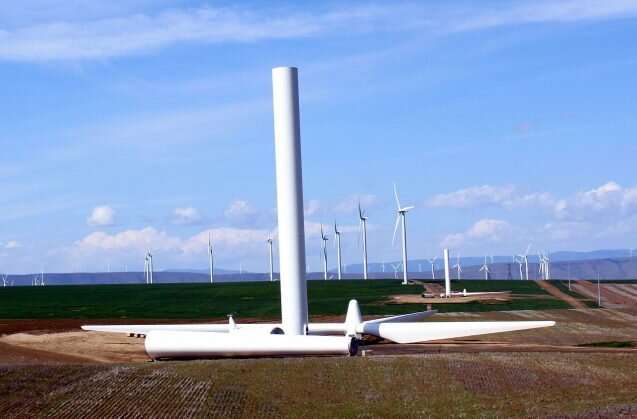Wind turbines under construction in the Biglow Canyon Wind Farm in 2009. Credit: Tedder/Wikimedia Commons
Regularly in the news, grocery stores, and at the pump, we are experiencing the limits of our planetary supply.
President Joe Biden has called for 500,000 new electric vehicle charging stations to be installed around the country to maintain the individual's freedom behind the wheel while reducing combustion emissions. This expansion is in conjunction with a call to convert electricity generation to renewables, as well as new requirements for batteries, wires, and other supporting materials to be manufactured in the US. On top of this, we'll also need to more than double the rate of expansion of transmission lines in order to move electricity from remote wind and solar farms to the population centers that will use it.
Meeting these goals—noble as they are—will challenge us to use limited, difficult-to-attain natural resources, such as copper. We will continue to feel a growing squeeze as demand increases on these natural resources. In truth, we don't even know if the planetary supply can meet such a vast demand.
Copper is a phenomenal mover (conductor) of electrons. Electrons, however they are harvested, are moved across space to the end user via copper or copper alloy wires and transmission lines. Although seemingly available, copper may make up only about 0.0006% of the Earth's crust. There is no way to have a clear inventory of how much copper is available. What we do know is that demand for copper has increased dramatically over the last few decades. And, like many other elements humans consume, the price of copper goes up with the increase in demand, the difficulty of extracting, and the cost of moving it.
When I'm baking a sourdough loaf, I know that I need five cups of flour and one cup of starter. Without enough, I put the baking off to another day and source more ingredients. In this example, it is easy to know how much flour I need and how much is available, and thereby plan how much and when to make the bread. The same information is not so readily available for the metals and ores we need in order to build out the grid and other necessary technologies; we do not know how much we can build because we do not know how much is available. This lack of information makes me worry that the green energy transition plan may be only half-baked.
My concerns are corroborated by environmental analyst Lester Brown, who thinks we should restructure taxes to get the market to tell the environmental truth, and Ira Joralemon, a geologist and copper mining expert of the early 20th century, who wrote in 1924:
"… the age of electricity and of copper will be short. At the intense rate of production that must come, the copper supply of the world will last hardly a score of years. … Our civilization based on electrical power will dwindle and die."
Twenty years have come and gone, but Joralemon's criticism of the idea that growth and demand can be continuous while planetary supply remains constant resonates deep understanding and honor of the planetary restoration process and limitations. Materials like copper, lithium, and iron ore, with restoration cycles longer than the span of human existence, will eventually be permanently exhausted; let us question building a society on that exhaustible foundation rather than a regenerative one.
Deep sea deposits of minerals, including copper, are lauded as a savior and a stop gap to the increasing demand. It is important to know that human knowledge of space is more comprehensive than that of our home planet's oceans. Only 50 years ago, scientists thought the midnight (bathypelagic) zone of the ocean was void of life—boy were they wrong. The non-photosynthetic life there was huge and prolific, but difficult to study. Even with robotic excavators, this is a dangerous, isolated, unpredictable, and abrasive environment to work in.
The environmental effects of deep sea mining likely would not be pretty, either. After extraction or dredging, a slurry of deep sea flotsam and jetsam would be left to linger in the sunlight (epipelagic) zone of the ocean, along with the plastic and the megafauna we love. On land, we see the consequences of similar types of extraction in the form of dead zones where plants do not grow, and polluted water that is undrinkable nor swimmable and makes people, plants, and animals sick. We can only imagine, and hopefully will not find out, the consequences of such abuse on our global climate regulator—the oceans. Already our planet's seas are struggling with rising temperatures, shifting currents, and increasing acidity. The consequences and costs of deep sea mining accidents could be irreversible, both due to the remoteness of the mining sites and the delicate nature in which they are situated.
The proposed US goal to double electricity transmission lines and build a separate electric vehicle charging network while also expanding solar and wind production to move to 100% renewable generation is, perhaps, not the panacea without consequence that we'd like to imagine. We need to set realistic expectations, increase recycling, reduce redundancy, and make the most of the limited resources we have available. And eventually, we may need to find more regenerative ways to sustain our civilizations.
Provided by Earth Institute at Columbia University
This story is republished courtesy of Earth Institute, Columbia University http://blogs.ei.columbia.edu.
























